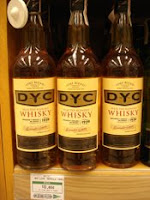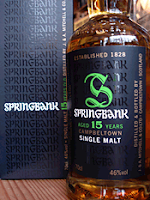
There are six major regions of whisky production in Scotland and each region has it's own general characteristics. Of course, there are exceptions to every rule but here I will explain these basic regional characteristics and this may help you to select which style of whisky will suit your taste. Within each region, each distillery also has it's own individual characteristics and this diversity gives us the different styles of the same drink and is what makes the world of whisky so interesting. There are currently over 80 distilleries in operation throughout Scotland.
Lowlands
The Lowlands was once a major area of production but fell on hard times in the 1980s and early 1990s. Currently there are only three operating distilleries - Glenkinchie, Auchentoshan and Bladnoch (which was closed in 1993 and reopened in 2000). 'The Highland line' runs to the north of Glasgow and Edinburgh and this imaginary line is the boundary between the Lowlands and the Highlands whisky regions. The style of whisky produced in the Lowlands is light, fresh and fruity and are regarded as very easy to drink. They are subtle and refreshing, good for hot weather and as an introduction to whisky for someone who has not tasted it before.
Highlands
The Highlands is the largest region and contains some of Scotland's remotest distilleries. The distilleries are spread far and wide and include Glengoyne that is very close to 'the Highland line', Oban on the west coast, Dalwhinnie in the middle of the Grampians and Old Pulteney up in the far north. There is a large diversity of styles due to the geographical locations but generally the whiskies produced are richer, sweeter and more full bodied than from anywhere else in Scotland. Distilleries that are located by the coast can also have a salty element to their whiskies, due to the casks breathing in the sea air during maturation.
Speyside
It is within this region that there is the largest concerntration of distilleries in Scotland. There are currently over 30 in operation within what is a relatively small area, based around the towns of Elgin, Rothes, Dufftown, Keith and the surrounding glens. This has historically always been the case and is due to the combination of perfect climate for whisky maturation, quality water supply and locality to the quality barley growing areas. The whiskies produced include some of the most famous in the world, such as Glenfiddich, Macallan and Glenlivet, but also a number of hidden gems. The style is generally reasonably light with pronounced malty flavours and some sweetness. Speyside whiskies sit somewhere between the light Lowland whiskies and the richer, sweeter Highland whiskies. This is what makes them so popular.
Campbeltown
Campbeltown is found on a peninsula on the west Highland coast. It was once home to 15 distilleries but the industry there fell on hard times, partly due to the remoteness of it's location and the resulting problems in transportation. Now there are currently only three operating distilleries in Campbeltown - Springbank, Glen Scotia and Glengyle (which has only just reopened in 2004, having been closed way back in 1925). They all use peated malt and the resulting whiskies have a light smoky flavour mixed with some maltiness and sweetness. They would be good examples to give to someone who was wanting to try a smoky whisky but not something too heavy or overpowering.
Islands
There are a number of distilleries that are based on the islands around the Scottish coast. These are Arran (on the isle of Arran unsurprisingly!), Jura (on the isle of Jura!), Tobermory (on Mull), Talisker (on Skye) and Highland Park and Scapa (on the Orkneys). There is no distinct style and all are pretty unique due to their locations. Generally, Arran and Scapa are the lighter and fresher whiskies, Jura and Tobermory are richer, sweeter and maltier while Talisker and Highland Park offer full bodied whiskies with some smokiness.
Islay
The island of Islay is the traditional home of smoky whiskies. Six of the eight operating distilleries produce the best smoky whiskies in the world and include some very famous names (the six are Ardbeg, Bowmore, Caol Ila, Kilchoman, Lagavulin and Laphroaig). The other two are Bruichladdich and Bunnahabhain, whose whiskies are normally unpeated and non smoky, but they do both occassionally produce limited edition smoky ones. The Islay whisky industry is booming and production on the island is at an all time high to meet demand. The industry runs the island's economy by giving jobs not just in manufacturing but in other areas, such as tourism. The whiskies are full bodied, smoky and complex. However, they are not to everyone's taste as they are so full on but are definitely worth a try. How will you know if you like it (or don't like it) if you don't try some?
 We found this blended whisky on our recent trip to Spain and having never heard of it, thought that we would give it a try. DYC is the abbreviated company name of Destilerias y Crianza del whisky, which opened Spain's first whisky distillery in 1959. The distillery is located in the town of Palazuelos de Eresma in the Castilla y Leon region to the north west of Madrid and has the capacity to produce a massive 20 million litres of spirit per year. The whisky is marketed to be low budget and is popular in Spain as it is much cheaper than Scottish, Irish or American whiskies. It is designed to be mixed with non alcoholic beverages and be easy drinking in the hot weather. A one litre bottle will cost you between 10-12 euros (about £8-10). This regular DYC release is a blend of malt and grain whiskies that have been matured in crianza red wine casks. So we had to try it!
We found this blended whisky on our recent trip to Spain and having never heard of it, thought that we would give it a try. DYC is the abbreviated company name of Destilerias y Crianza del whisky, which opened Spain's first whisky distillery in 1959. The distillery is located in the town of Palazuelos de Eresma in the Castilla y Leon region to the north west of Madrid and has the capacity to produce a massive 20 million litres of spirit per year. The whisky is marketed to be low budget and is popular in Spain as it is much cheaper than Scottish, Irish or American whiskies. It is designed to be mixed with non alcoholic beverages and be easy drinking in the hot weather. A one litre bottle will cost you between 10-12 euros (about £8-10). This regular DYC release is a blend of malt and grain whiskies that have been matured in crianza red wine casks. So we had to try it! I got a strange look from the bar woman when we ordered it straight and she almost insisted that we had some cola with it. She then proceeded to pour me the rest of the bottle which must have been the equivalent to a quadruple shot (or a quintuple, if that's a real word) and this left me wondering what we had let ourselves in for and how popular this stuff really was? How long had she had that bottle sitting there? Had she won a prize from her boss for finishing the bottle off? This cost me only 7 euros! The colour is a very pale gold and the nose is very light with almost nothing there. There is a bit of vanilla and caramel with a whiff of alcohol and petrol (never a good sign, but then we were sitting outside next to a main road!). On the palate, it is again very light with the vanilla notes prominent and also something herbal (think of fresh cut grass) coming through. The finish is short, very sharp and almost acidic. We were both pleasantly surprised that it was actually quite nice! It doesn't have the complexity of other whiskies that we have tried but was thirst quenching and we could see how it was popular in a hot climate, maybe with ice or a mixer. This is a simple blended whisky with minimal character (we thought there would be more influence from the crianza wine casks, as this is a full bodied red wine that should add more fruitiness) but one that is easy drinking, refreshing and dirt cheap. If you are ever in Spain, it is worth a try.
I got a strange look from the bar woman when we ordered it straight and she almost insisted that we had some cola with it. She then proceeded to pour me the rest of the bottle which must have been the equivalent to a quadruple shot (or a quintuple, if that's a real word) and this left me wondering what we had let ourselves in for and how popular this stuff really was? How long had she had that bottle sitting there? Had she won a prize from her boss for finishing the bottle off? This cost me only 7 euros! The colour is a very pale gold and the nose is very light with almost nothing there. There is a bit of vanilla and caramel with a whiff of alcohol and petrol (never a good sign, but then we were sitting outside next to a main road!). On the palate, it is again very light with the vanilla notes prominent and also something herbal (think of fresh cut grass) coming through. The finish is short, very sharp and almost acidic. We were both pleasantly surprised that it was actually quite nice! It doesn't have the complexity of other whiskies that we have tried but was thirst quenching and we could see how it was popular in a hot climate, maybe with ice or a mixer. This is a simple blended whisky with minimal character (we thought there would be more influence from the crianza wine casks, as this is a full bodied red wine that should add more fruitiness) but one that is easy drinking, refreshing and dirt cheap. If you are ever in Spain, it is worth a try.



